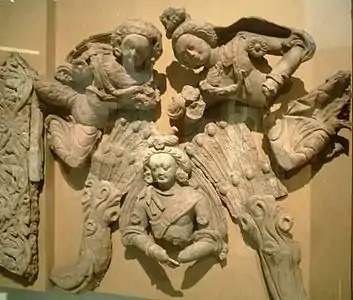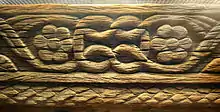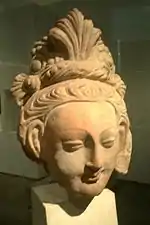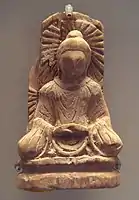Serindian art
Serindian art is the art that developed from the 2nd through the 11th century C.E. in Serindia or Xinjiang, the western region of China that was within the cultural sphere of Central Asia during the time.

It derives from the Greco-Buddhist art of the Gandhara district of what is now Afghanistan and Pakistan. Gandharan sculpture combined Indian traditions with Greek influences. Greek-influenced culture was most probably in existence prior to Alexander the Great's invasions. Afghanistan natives retained this influence which was lost in Greece.
Modern researchers hypothesize that Buddhist missionaries travelling on the Silk Road introduced this artistic influence, along with Buddhism itself, into Serindia, resulting in a style that is a hybrid of Greek, Chinese and Persian.
In modernity, Serindian art was rediscovered through the expeditions of Sir Aurel Stein in Central Asia at the beginning of the 20th century.
 Carved wooden beam in Hellenistic style, 3rd-4th century
Carved wooden beam in Hellenistic style, 3rd-4th century Serindian group, 6th-7th century terracotta, Tumshuq (Xinjiang)
Serindian group, 6th-7th century terracotta, Tumshuq (Xinjiang) Head of a Serindian man, 6th-7th century terracotta, Tumshuq (Xinjiang)
Head of a Serindian man, 6th-7th century terracotta, Tumshuq (Xinjiang) Head of a Serindian female Bodhisattva, 6th-7th century terracotta, Tumshuq (Xinjiang)
Head of a Serindian female Bodhisattva, 6th-7th century terracotta, Tumshuq (Xinjiang) Serindian head, 6th-7th century terracotta, Tumshuq (Xinjiang)
Serindian head, 6th-7th century terracotta, Tumshuq (Xinjiang) A Buddha statue from Tumshuq, Xinjiang. 5th century.
A Buddha statue from Tumshuq, Xinjiang. 5th century.
References
- Hopkirk, Peter (1980). Foreign Devils on the Silk Road: The Search for the Lost Cities and Treasures of Chinese Central Asia. Amherst: The University of Massachusetts Press. ISBN 0-87023-435-8.
External links
| Wikimedia Commons has media related to Serindian art. |